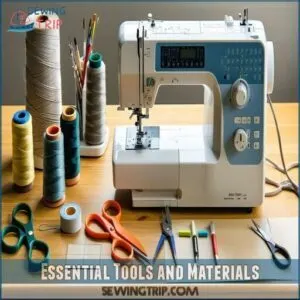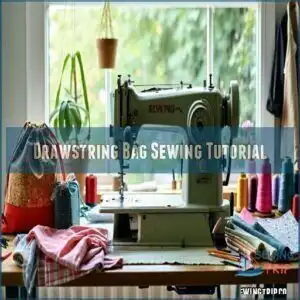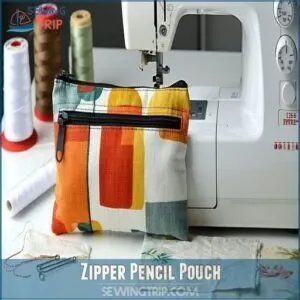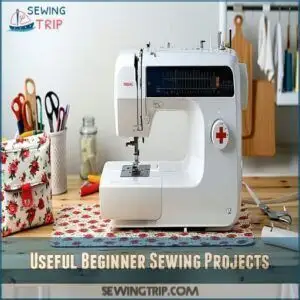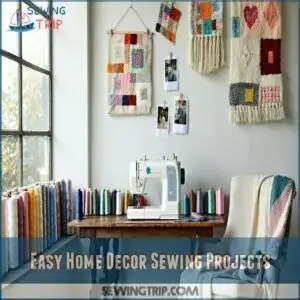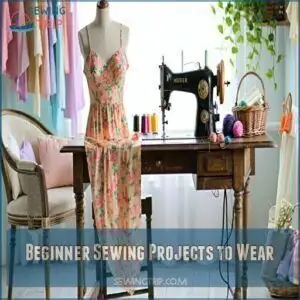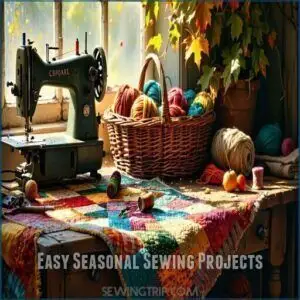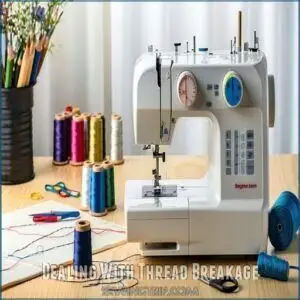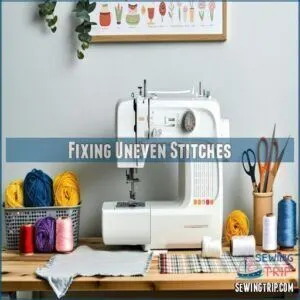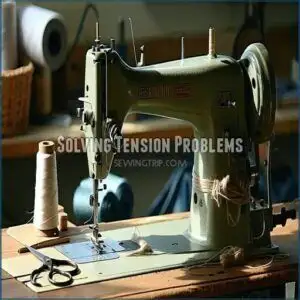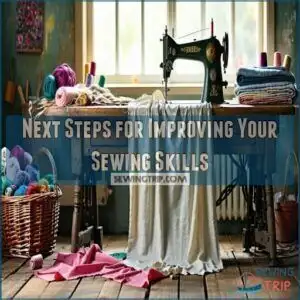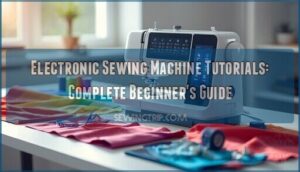This site is supported by our readers. We may earn a commission, at no cost to you, if you purchase through links.
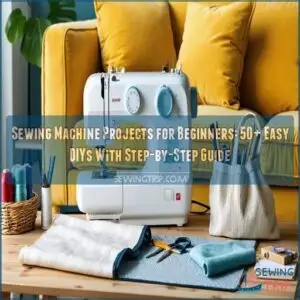 If you’re new to sewing, start with simple sewing machine projects for beginners with instructions like pillowcases, drawstring bags, or zipper pouches.
If you’re new to sewing, start with simple sewing machine projects for beginners with instructions like pillowcases, drawstring bags, or zipper pouches.
These projects are perfect for building confidence while learning basics like straight stitching and handling fabric. For a practical twist, try a phone charging station or a portable first-aid kit—both are beginner-friendly and super useful!
You’ll need essential tools like a reliable sewing machine, sharp scissors, and a seam ripper (trust me, mistakes happen). Set up a comfy, well-lit workspace, and you’re ready to go.
With a little patience, you’ll be stitching like a pro in no time, and don’t forget to use your new skills to create something super useful!
Table Of Contents
- Key Takeaways
- Essential Tools and Materials
- Getting Started With Sewing Machine Projects
- Beginner-Friendly Sewing Projects
- Useful Beginner Sewing Projects
- Easy Home Decor Sewing Projects
- Beginner Sewing Projects to Wear
- Essential Sewing Tips for Beginners
- Easy Seasonal Sewing Projects
- Troubleshooting Common Sewing Machine Issues
- Next Steps for Improving Your Sewing Skills
- Frequently Asked Questions (FAQs)
- Conclusion
Key Takeaways
- You’ll build confidence and skills by starting with simple sewing machine projects like pillowcases, drawstring bags, or zipper pouches, which are perfect for practicing straight stitching and handling fabric.
- To get started, you’ll need essential tools like a reliable sewing machine, sharp scissors, and a seam ripper, and it’s crucial to set up a comfy, well-lit workspace that helps you focus on your projects.
- As you progress, you can move on to more practical and useful projects like phone charging stations, portable first-aid kits, or pattern weights, which will help you develop your sewing skills while creating something super useful.
- Don’t be afraid to make mistakes – they’re an essential part of the learning process, and with patience and practice, you’ll be stitching like a pro in no time, creating beautiful and practical items that you’ll love to use and show off.
Essential Tools and Materials
Before diving into your sewing journey, let’s gather the essential sewing notions that’ll set you up for success. At the heart of your crafting arsenal is a reliable sewing machine – think of it as your creative partner in this adventure.
You’ll need sharp fabric scissors (keep them separate from your paper ones!), straight pins with colorful heads for easy spotting, and a trusty seam ripper for those learning moments. Among your measuring tools, include a flexible tape measure and fabric chalk for precise markings.
Stock up on basic thread types in neutral colors, plus machine needles in various sizes. For fabric selection, start with cotton – it’s forgiving and perfect for beginners. Don’t forget sewing machine accessories like extra bobbins and a cleaning brush.
Understanding proper sewing tool maintenance is essential for extending the life of your equipment. Store your sewing supplies in clear containers – you’ll thank yourself later when searching for that perfect notion mid-project!
Getting Started With Sewing Machine Projects
You’ll find that starting your sewing journey doesn’t have to be complicated, even if your machine has been sitting untouched in the closet.
With just a few basic supplies and some simple steps, you’ll be creating beautiful projects in no time.
From pillowcases to tote bags that you’ll actually use, these creations will be a testament to your newfound skill, making the journey worthwhile as you enjoy your simple steps towards sewing mastery.
Familiarizing Yourself With Your Sewing Machine
Inside your sewing machine lies a world of creative possibilities. Think of it as your crafting companion, ready to bring your ideas to life!
Before diving into projects, let’s get comfortable with your machine’s personality.
- Start with Machine Basics – explore the feel of the foot pedal and practice Stitch Control.
- Master Thread Types and Bobbin Management through regular practice.
- Follow simple sewing machine tutorials while maintaining Sewing Safety.
You’re on your way to becoming a confident creator!
Basic Sewing Machine Parts and Functions
Your sewing machine might look like a puzzle at first, but its parts work together like a well-rehearsed dance.
The needle drives through fabric while working with the presser foot, which holds your material steady.
Below deck, the bobbin supplies thread from underneath, creating perfect stitches with the top thread.
You’ll get to know the thread tension dial, which controls stitch tightness, and the stitch length selector for different sewing needs.
Each part plays an essential role, like musicians in an orchestra, they create beautiful results when working in harmony.
Setting Up Your Workspace for Sewing
While a dedicated sewing workspace might seem like a luxury, it’s actually your ticket to crafting success.
Create a well-lit station near natural light or invest in a good desk lamp to prevent eye strain.
Your ergonomic setup should include:
- A sturdy table at elbow height for your sewing machine and supplies
- A comfortable chair that supports proper posture
- Smart storage solutions within arm’s reach
Keep your workspace tidy and organized – you’ll spend more time creating and less time hunting for that missing thread, which is key to sewing success and maintaining a comfortable workspace.
Beginner-Friendly Sewing Projects
You’ll find creating your first sewing projects easier than you think, with fun options like pillowcases, drawstring bags, and simple pouches that’ll build your confidence.
With these beginner-friendly projects, you’ll learn essential sewing skills while making useful items for your home and family.
Simple Pillowcase
Making your first pillowcase couldn’t be simpler! As a popular sewing machine project for beginners, it’s the perfect way to learn basic techniques.
Choose your favorite fabric patterns and matching thread colors – whether it’s cheerful florals or calming stripes. You’ll need basic sewing notions and about a yard of fabric based on your desired pillow sizes.
With just a few straight seams and easy sewing tutorials to guide you, you’ll create something both beautiful and practical. Best of all, you’ll proudly say, "I made this!" every night.
Starting with simple projects like a pillowcase can help you develop essential sewing machine skills that can be applied to more complex tasks.
Drawstring Bag Sewing Tutorial
After mastering pillowcases, you’ll love creating drawstring bags – they’re perfect for beginner sewing projects. Your fabric choices can range from playful prints to elegant solids, and you’ll need basic sewing notions like thread and scissors.
These versatile bags work for everything from storing shoes to wrapping gifts. Understanding sewing bag materials is important for successful projects.
- Start small with a jewelry pouch using cotton prints and matching thread colors
- Level up to medium bag sizes for gym clothes or travel essentials
- Challenge yourself with larger storage bags once you’re comfortable
You’ll be amazed at how quickly these easy sewing projects for beginners come together!
Zipper Pencil Pouch
Now that you’ve got the hang of drawstring bags, let’s create something that’ll keep your pencils from playing hide-and-seek. A zipper pencil pouch is your next perfect project – it’s fun, practical, and helps you practice working with zippers.
You’ll want to pick medium-weight cotton fabric that won’t slip while you’re sewing. Choose a zipper that’s slightly longer than your planned pouch width – you can always trim it later.
Remember, your first pouch mightn’t look store-bought perfect, but those slightly wonky stitches? They’re what make your creation uniquely yours!
Useful Beginner Sewing Projects
You’ll love creating these practical sewing projects that make your everyday life easier, from charging stations that keep your phone cords tidy to pattern weights that help you cut fabric like a pro.
Once you’ve mastered these handy items, you’ll wonder how you ever lived without your handmade first-aid kit and other useful accessories that show off your new sewing skills.
Phone-Charging Station Tutorial
A clever phone charging station brings order to your desk’s cable chaos. This beginner-friendly sewing project transforms basic materials into a stylish tech organizer.
- Cut two 12×16 inch fabric rectangles for the main body
- Add sturdy interfacing for professional structure
- Create divided sections for USB hubs and power banks
- Sew elastic strips to secure your devices safely
- Include a zippered pocket for charging pads and accessories
You’ll love how this practical phone holder keeps your cables managed and devices organized while showcasing your sewing skills.
Portable First-Aid Kit Pattern
Your sewing journey’s about to get even more practical!
A portable first-aid kit transforms scattered medical supplies into an organized, travel-ready companion.
With your beginner sewing machine, you’ll create custom pockets for bandages and medical tape, turning fabric into a smart medical pouch.
It’s the perfect blend of creativity and practicality – because when adventure calls, you’ll want those Band-Aids within easy reach!
Mastering beginner sewing projects can help you create more useful items like this.
Pattern Weights for Beginners
Pattern weights are like a third hand when you’re cutting fabric – they hold everything perfectly still without leaving holes.
You’ll save money by making your own set using metal washers from the hardware store wrapped in fabric scraps.
As a beginner-friendly sewing project, these crafting tools give you better fabric control than pins, plus, you can customize their size and weight to match your needs.
Easy Home Decor Sewing Projects
You’ll transform your home with these simple yet stylish DIY decor projects that won’t make your sewing machine (or you) break a sweat.
From quick table runners to pretty fabric napkins, you’ll find that creating custom touches for your space is both fun and budget-friendly when you can make them yourself.
Quick and Easy Table Runner Tutorial
Your dining table deserves a dash of handmade charm! This beginner-friendly table runner project lets you practice straight-line sewing while creating something beautiful for your home.
Fabric selection is key—choose something that complements your décor. When selecting fabrics, consider table runner materials to achieve the best results.
To create your table runner, follow these steps:
- Measure your table’s length and add 12 inches for an elegant overhang
- Cut fabric twice as wide as your desired runner width
- Press seams with a hot iron for professional-looking edges
- Topstitch ¼ inch from edges for that polished, store-bought finish
Fabric Napkins for Beginners
After mastering table runners, let’s tackle fabric napkins—an environmental win-win that’s beginner-friendly.
Choose cotton fabrics in patterns you love, then cut 18-inch squares. Simply fold each edge twice (about ¼ inch), press with an iron, and stitch.
Voilà! You’ve created beautiful, washable napkins while practicing your hemming techniques. They’re perfect for holidays, gifts, or elevating everyday meals.
No special sewing notions required—just straight seams! Creating these napkins is a great example of easy home decor projects that can enhance your space, making it a wonderful easy home decor project and a great way to achieve an environmental win.
Fringed Table Runner Pattern
Now that you’ve mastered napkins, let’s add some flair to your table with a stunning fringed runner.
You’ll transform simple cotton or linen fabric into an elegant accent piece that looks store-bought.
Start by measuring your table’s length and add 12 inches for those eye-catching fringe ends.
Creating even tassels is surprisingly easy – just pull threads from each end and secure with a straight stitch.
In just a few hours, you’ll have a designer-worthy table runner that’s sure to impress dinner guests.
Beginner Sewing Projects to Wear
You’ll love creating your own wardrobe with these beginner-friendly sewing projects that’ll make you feel like a fashion designer in no time.
From comfy pillowcase dresses to stylish clutches and practical aprons, you’ll find projects that are perfect for showing off your new sewing skills while looking great, and making you feel like a true designer.
Pillowcase Dresses and Tops Tutorial
Looking to create something you can actually wear? You’ll love turning pillowcases into beautiful dresses and tops! These beginner-friendly sewing projects let you practice basic garment construction while making something uniquely yours.
Here’s what makes pillowcase dresses perfect for beginners:
- The fabric’s already hemmed on three sides, saving you time and effort
- Simple straight-line sewing means you can focus on basic techniques
- Easy fitting adjustments with elastic or ribbon casings
Start with these sewing techniques:
- Choose light cotton pillowcases for breathability
- Mark and cut armholes carefully (measure twice!)
- Add personal touches with decorative trim or pockets
Want a pro tip? Practice your straight stitches on scrap fabric first – you’ll thank yourself later when working on your dress!
Easy Clutch Pattern for Beginners
Three simple pieces of fabric can transform into your new favorite clutch design.
This beginner-friendly project introduces essential sewing tips while creating something you’ll love to carry. You’ll need medium-weight cotton for structure and a fun print for personality.
With your sewing machine, you’ll master straight stitches and basic closures. Add a magnetic snap or button, and you’ve got a stylish bag that fits your phone and essentials.
Your handmade clutch will rival any boutique find.
30. Minute Apron Tutorial
Create a stylish kitchen companion in just 30 minutes with this beginner-friendly apron pattern.
You’ll need one yard of cotton fabric – those fun prints you’ve been saving are perfect for this project.
The simple design makes it easy to adjust the fit to your liking, while straight seams keep sewing basics straightforward.
With a few clever shortcuts and your trusty sewing machine, you’ll have a custom apron ready for your next culinary adventure!
Essential Sewing Tips for Beginners
You’ll be amazed at how a few simple tips can transform your sewing projects from frustrating to fantastic.
Whether you’re wrestling with wobbly stitches or tangled threads, these beginner-friendly tips will help you create beautiful, professional-looking projects that you’ll be proud to show off.
Precise Cutting and Pressing Techniques
With sharp cutting tools in hand, you’ll transform fabric into perfectly sized pieces for your sewing machine projects. Your scissors and rotary cutter should glide smoothly along the fabric grain, creating clean edges that’ll make your seam allowances spot-on.
Keep your pressing tools nearby – they’re just as crucial as your cutting gear. A well-positioned ironing board and hot iron are your best friends for creating crisp, professional-looking seams.
Here’s a pro tip: press (don’t iron) each seam as you sew. Your seams will thank you with that polished, store-bought look.
Choosing Forgiving Fabrics for Beginners
Now that you’ve got your cutting skills down, let’s talk about fabric – your new best friend in sewing.
When you’re starting out, cotton and cotton blends are your secret weapons. These natural fibers play nice with your machine and won’t slip around while you work.
Choose medium-weight fabrics with clear weave patterns and moderate thread counts. They’re like training wheels for your sewing journey – stable, forgiving, and ready to help you succeed.
For more guidance, consider exploring forgiving fabrics to find the perfect match for your projects.
Avoiding Synthetic Fabrics for Sewing
When starting your sewing journey, many beginners make the mistake of choosing synthetic fabrics.
These materials aren’t just tricky to work with – they can actually melt under your iron! Instead, reach for natural fibers like cotton and cotton blends.
They’re more forgiving when you’re learning, plus they’re eco-friendly and sustainable. Your sewing machine will run smoother, and you’ll find simple sewing projects much more enjoyable.
Think of it as setting yourself up for success from the start. Choosing the right fabric is key and learning about synthetic fabric risks can help you make informed decisions.
Easy Seasonal Sewing Projects
You’ll love creating seasonal projects that match the changing weather and holidays, from cozy winter blankets to breezy summer tote bags.
Whether you’re making festive holiday decorations or practical items for different times of the year, these beginner-friendly projects will help you build your sewing skills.
These projects will help you add a personal touch to every season, making them a great way to enjoy sewing while creating something useful and fun.
Summer Sewing Projects for Beginners
As summer sunshine beckons, your sewing machine can help create the perfect seasonal wardrobe and accessories.
Transform lightweight cotton into breezy summer dresses or comfy shorts for those warm days ahead. You’ll love crafting a roomy beach bag for seaside adventures or fabric covers to protect your outdoor décor.
These beginner-friendly projects use simple stitches and forgiving materials, making them perfect for new sewists.
Start with easy patterns like a reversible sun hat or a quick-sew picnic blanket – you’ll be amazed at what you can make!
Winter Sewing Projects for Beginners
When chilly winds blow, you’ll find comfort in creating cozy winter sewing projects right at your machine.
These beginner-friendly crafts will keep you warm while building your skills:
- Make a fleece hat with ear flaps – perfect for morning walks and snowball fights
- Create mittens from old sweaters – they’re quick to sew and super warm
- Craft a draft stopper filled with rice – it blocks cold air and saves on heating bills
You can also whip up some snowflake decor pillows or a simple ice scraper mitt. These winter sewing projects are practical and fun – plus, they make thoughtful handmade gifts!
Holiday-Themed Sewing Projects
While winter brings cozy indoor crafting time, holiday sewing projects add extra sparkle to your home.
You’ll discover how simple patterns transform into treasured decorations and gifts.
| Project | Difficulty | Time | Materials |
|---|---|---|---|
| Holiday Stockings | Easy | 2 hours | Felt, cotton |
| Santa Hats | Beginner | 1 hour | Fleece, trim |
| Christmas Ornaments | Easy | 30 mins | Fabric scraps |
| Winter Decor | Beginner | Various | Mixed fabrics |
From festive gift wrappers to charming tree decorations, these beginner-friendly sewing projects spread holiday cheer through every stitch.
Troubleshooting Common Sewing Machine Issues
When your sewing machine acts up, it can feel like it’s got a mind of its own, but don’t worry—you’ve got this!
From thread breakage to tension troubles, we’ll tackle these common hiccups step by step so you can get back to creating.
Dealing With Thread Breakage
Thread breakage can turn your sewing machine projects into a frustrating puzzle.
The culprit? Often it’s thread tension that’s wound too tight, like a guitar string about to snap.
Check your bobbin issues first – a poorly wound bobbin can cause all sorts of mischief.
Low-quality thread can also be the troublemaker, so stick with trusted brands.
When you’re excited to finish, remember that sewing speed matters – rushing through can lead to snaps.
Take it slow, and you’ll see smoother stitching every time.
Fixing Uneven Stitches
Struggling with uneven stitches? Let’s fix that! First, check your needle—it needs to match your fabric choice, like picking the right tool for the job.
Next, inspect your bobbin; poorly wound bobbins cause chaos. Adjust your sewing speed to keep things smooth—slow and steady wins here.
Solving Tension Problems
Tension problems can feel like your sewing machine’s way of throwing a tantrum, but it’s nothing a little troubleshooting can’t fix.
Thread tension issues often show up as uneven stitches or loops on your fabric.
Here’s how to tackle them:
- Adjust the thread tension dial: Start small—turn it slightly and test on scrap fabric.
- Inspect the bobbin: Is it threaded correctly and seated snugly? Bobbin issues can throw everything off.
- Clean the machine: Lint and debris love hiding in the bobbin area, messing with sewing machine calibration.
If things still look wonky, don’t stress. Practice tension adjustment on different fabrics to understand stretch and behavior. Soon, you’ll master your sewing machine’s quirks like a pro!
Next Steps for Improving Your Sewing Skills
You’ve mastered the basics, so now it’s time to challenge yourself with new techniques and projects.
Don’t worry, mistakes are just part of the fun and a great way to learn!
Practicing New Techniques and Projects
Ready to level up? Jump right into new sewing machine projects for beginners! Try a tote bag or experiment with bold fabrics. Mistakes? They’re just stepping stones.
Here’s a quick guide:
| Skill | Practice Idea | Why It Helps |
|---|---|---|
| Sewing Basics | Straight stitch lines | Builds precision |
| Fabric Selection | Mix cotton blends | Enhances versatility |
| Stitch Variations | Zigzag stitching | Adds decorative flair |
Keep exploring beginner sewing ideas and sewing projects for beginners with instructions—your creativity is limitless!
Exploring Advanced Sewing Topics
It’s time to level up your sewing game and discover a world of creativity! Move beyond beginner sewing ideas and explore techniques that’ll make you feel like a pro.
Master fabric manipulation to add texture and depth, or try advanced embellishments like beading or embroidery for a personal touch. Experiment with pattern drafting to create custom designs, and explore sewing technology with features like speed control and automatic thread cutters.
Don’t forget sewing hacks to keep your machine in peak shape.
- Fabric manipulation tricks
- Garment tailoring tips
- Pattern drafting basics
- Textile science insights
- Advanced sewing machine tutorials
Joining Sewing Communities for Support
Joining sewing communities is like finding your tribe.
Jump into online forums or sewing groups to share wins, ask questions, and trade sewing tips for beginners.
Social media brims with inspiration, while local classes and community events offer hands-on fun.
Don’t overlook sewing blogs or online sewing classes for fresh ideas.
Whether you’re swapping fabric or tackling sewing machine projects for beginners, these connections spark creativity.
Who knows? Your next masterpiece might come from a sewing forum chat!
Frequently Asked Questions (FAQs)
What is the easiest thing to sew as a beginner?
Think of sewing as planting seeds of creativity.
Start with a simple pillowcase—it’s forgiving, straight-line sewing.
You’ll build confidence stitching something useful, and mistakes?
They’re just happy little accidents on your journey to mastery!
What to make with a sewing machine for beginners?
Start with simple projects like pillowcases, tote bags, or drawstring pouches.
They’re quick, forgiving, and build confidence.
Plus, who doesn’t love creating something useful while mastering straight stitches?
It’s sewing magic in action!
What can I sew in 30 minutes?
You can whip up a drawstring bag, fabric headband, or a simple pillowcase in 30 minutes.
They’re quick, fun, and perfect for practicing basic sewing skills without breaking a sweat—instant gratification!
Can I teach myself to use a sewing machine?
Teaching yourself to use a sewing machine is doable.
Start small—read the manual, practice threading, and sew straight lines on scrap fabric.
Mistakes happen, but they’re just stitches in your learning journey!
What is the easiest thing to sew for beginners?
Did you know 60% of beginners start with pillowcases?
They’re easy, forgiving, and teach straight stitching.
Plus, you’ll love seeing your work on display every night—talk about instant gratification with a cozy reward!
What is the easiest sewing machine to learn on?
You’ll love starting with a Brother CS7000X or Singer Start
They’re user-friendly, affordable, and built for beginners.
Both offer simple controls, clear instructions, and just enough features to keep things fun, not overwhelming.
How to choose a beginner-friendly sewing pattern?
Picking a beginner sewing pattern is like choosing a training wheel for your creativity.
Start simple—look for clear instructions, minimal pieces, and forgiving fabrics like cotton.
Avoid complex techniques; you’ll grow into those later!
What type of fabric is easiest for beginners?
Cotton or cotton blends are your best bet—they’re like the training wheels of fabric.
They’re easy to cut, don’t slip around, and press well.
Avoid slippery synthetics; they’re a frustration waiting to happen!
How do I set up a sewing machine?
Place your sewing machine on a sturdy table, plug it in, and thread it following the manual’s guide.
Practice winding the bobbin, adjust tension settings, and test stitches on scrap fabric.
Relax—it’s easier than it looks!
Best lighting setup for sewing projects?
Don’t underestimate good lighting—it’s a game-changer!
Use a bright, adjustable desk lamp with daylight bulbs to reduce eye strain.
Position it so shadows don’t fall on your work.
Natural light? Even better!
Conclusion
Sewing builds creativity, confidence, and practical skills all at once.
With these sewing machine projects for beginners with instructions, you’re set to tackle fun, easy DIYs while mastering the basics.
Whether it’s a pillowcase, a zipper pouch, or a phone charging station, each project helps you grow your skills step by step.
Don’t rush—enjoy the process, embrace mistakes, and celebrate your progress.
Soon, you’ll be creating handmade treasures that are as useful as they’re beautiful!
- https://www.bhg.com/decorating/do-it-yourself/fabric-paper-projects/easy-sewing-projects/
- https://www.polkadotchair.com/50-fun-beginner-sewing-projects/
- https://sewcanshe.com/especially-for-beginners-50-free-sewing-patterns/
- https://flamingotoes.com/2015/06/15-minute-picnic-blanket/
- http://www.madeeveryday.com/2008/07/tutorial-a-simple-skirt.html/

